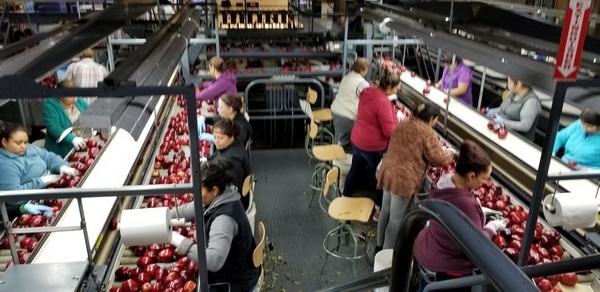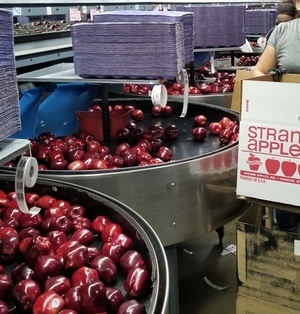
What kind of facility looks like a factory but isn’t? Or looks like a warehouse, but looks far more industrial than a typical facility with racks principally designed for storage? The “Added-Value Warehouse” is something of a hybrid. It is a facility that does some additional work on a product before it ships out rather than just storing, picking, packing and shipping previously finished products.
Some examples include catalogs that allow a custom hem your pants between picking and packing, or a kitting operation that requires 2 or more products or parts to be assembled or packaged together to be shipped as a “complete” product.
For our first look at one of these facilities, we are going to share something seasonal – a tour of an apple processing warehouse in Cowiche, WA, the home of the amazing Strand Apples. Apple processing has some unique logistics and handling processes, which we will include as well.
Lots to See in the “Apple Factory”
Washington State is by far the largest producer of apples in the US, accounting for about half of all production (and for craft beer lovers, they also grow over 70% of all the hops in the US too). The lava-ash rich soil of Eastern Washington, plenty of irrigation with fresh mountain water, cold winters (a requirement for apple trees) and elevations ranging from 500-3,000 feet above sea level give apple farmers in Washington an edge on every other region in the US. October is harvest time, and a drive through the region here provides views of fruit-bearing trees bearing the weight of dozens of apples on each of them.
This tour will be very visual… follow along below with the photos and videos, with a short explanation of each ABOVE the image:
Bringing them in From the Orchard

Apples are still mostly hand-picked and picked into large bins, each of which could weigh over 800 pounds when full (and nearly a thousand pounds when full of the pears, which are denser). While newer orchards have wider spacing to allow large tandem flatbread trucks into the orchards to be loaded by forklift, older orchards have a unique type of truck in operation called a “Straddle Truck.” These trucks look like steel-beam bridges on wheels, and while they appear to be relatively inefficient given the relative size of the truck compared to the number of bins they carry, these trucks have a unique feature. They are designed to back up over a stacked row of apple bins, which are sitting on a skid, and then lift it into the truck for transport to the warehouse.
Here is an example of how it works:
If you are ever driving around apple country here or in the other 35 states that have apple-growers, the trucks you see, and the bins stacked on them generally belong to the apple-growers themselves. In this case, the growers have some level of vertical integration in regard to their production, transportation, storage, processing, and shipping.
Why You See Apples Year-Round in Your Market
Producers generally have two kinds of facilities – the “Added Value Warehouse” where the processing takes place and a Cold Storage facility. For some growers, processing takes place year-round because they put a large majority of their apples into cold storage, which stops the apples from maturing any more than they have at the time they were harvested. They can then be moved as needed to the processing facility.
The following photos are from Strand’s Apples. They were very generous with a special tour:
Each bin gets pulled underwater which then allows the apples to float up and out before the bins come back out on the other side and get sent back into the orchards.

4. Wax Off! Wax On!
 Fruits like apples produce a natural wax that is designed to prevent the escape of moisture but in the process of washing off the dirt from the field is removed with the dirt. A wax from natural ingredients (certified by the US Food and Drug Administration) from natural sources that wax, such as Carnauba, the leaves of the Brazilian palm, or Candelia wax, which is derived from a reed-like dessert plant of the genus Euphorbia are applied to replace it. As one pound of wax can coat 160,000 pounds of apples, each apple gets the equivalent of about two small droplets of wax on it (not pictured).
Fruits like apples produce a natural wax that is designed to prevent the escape of moisture but in the process of washing off the dirt from the field is removed with the dirt. A wax from natural ingredients (certified by the US Food and Drug Administration) from natural sources that wax, such as Carnauba, the leaves of the Brazilian palm, or Candelia wax, which is derived from a reed-like dessert plant of the genus Euphorbia are applied to replace it. As one pound of wax can coat 160,000 pounds of apples, each apple gets the equivalent of about two small droplets of wax on it (not pictured).
5. Sorting Manually?
Yes, in this processing center, a team of sorters divides the apples into four different grades based on size and quality. Dividing them up here determines which packing station they will end up in which are also divided by destination (customer).

6. Scanning for Dropouts
One of the more sophisticated pieces of machinery in this added value facility is a scanner which can determine if an apple has any brown rot inside. Apples don’t bruise easily (especially at this stage after harvest) but sometimes will have brown rot which is a fungal disease. This scanner ensures a level of quality that cannot be handled with the human eye.

7. A Familiar Process – Labeling
Like most warehouses we talk about here, labels are a big part of the process. The first one starts here, with pre-printed labels that go onto each piece of fruit. Notice how the small wheel that is turning uses a vacuum to keep the label in place until it gets affixed to the apple.
8. Speed-Packing
With apples now cleaned, waxed, sorted, scanned and labeled, they are deposited into packing stations where a roll of labels is set up that is unique to the customer (destination) who is getting them. Packers then add a second label to each case which identifies them as the packer, so they can get credit for the case as they are paid for each case packed.


9. Scanning and Palletizing
Finally, each case gets weighed as it’s scanned, with underweight cases diverted for repacking, and then cases going to the same customer are palletized for shipment. Once they leave the facility, this will be the first time the apples leave the growers, who have been nurturing the fruit since they started as pink blossoms back in late Spring!
Where Do They Go?
EVERY single apple got processed and assigned a destination in this facility. Even those sorted out as being below the required quality for consumer distribution (either because of appearance, shape or other reasons) gets shipped to a local juice company who presses them into service (sic).
About 25% of the American apple and pear crop is exported to dozens of countries around the world. Depending on the customer, they will be picked at different times to ensure they arrive at their destination at their peak. Because cold storage stops the maturation process in apples, many varieties can be stored for up to a year before being sent to the processing facility, which is why you can find most of your favorite apples year-round in your supermarket.
More on Added Value Warehouses – and Apples
Does your business have any added-value processes in your facility? Do you treat them that way and measure them accordingly? The Added-Value Warehouse has great potential for customers to improve speed, quality, create customization options, etc. What opportunities are you potentially missing right now?
Apples are a nice simple example we can use to demonstrate how “Value-Added” works. And they are also delicious. Here is an excellent list of facts about apples you may not know.

Check out our award-winning new technology that can scan any package in any orientation, and even takes a photo of every item for tracking and claim protection.











